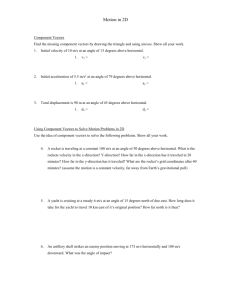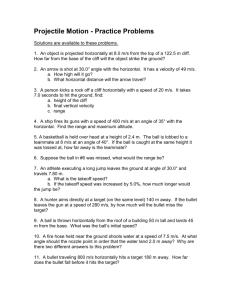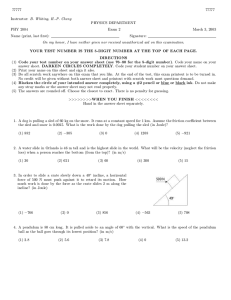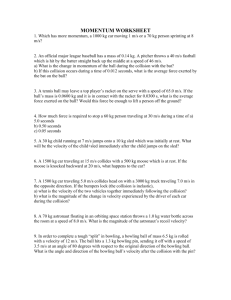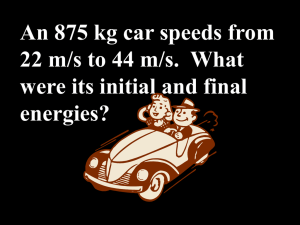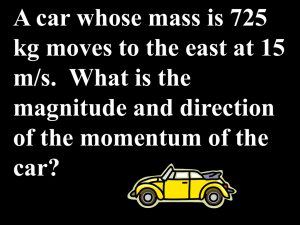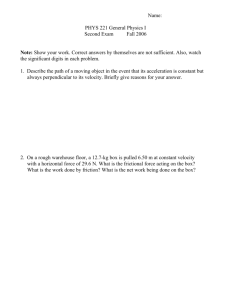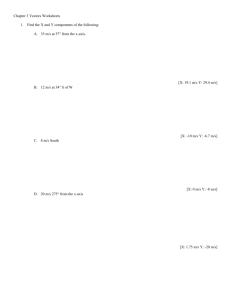Summer Practice 2015 - AP Physics 1
advertisement
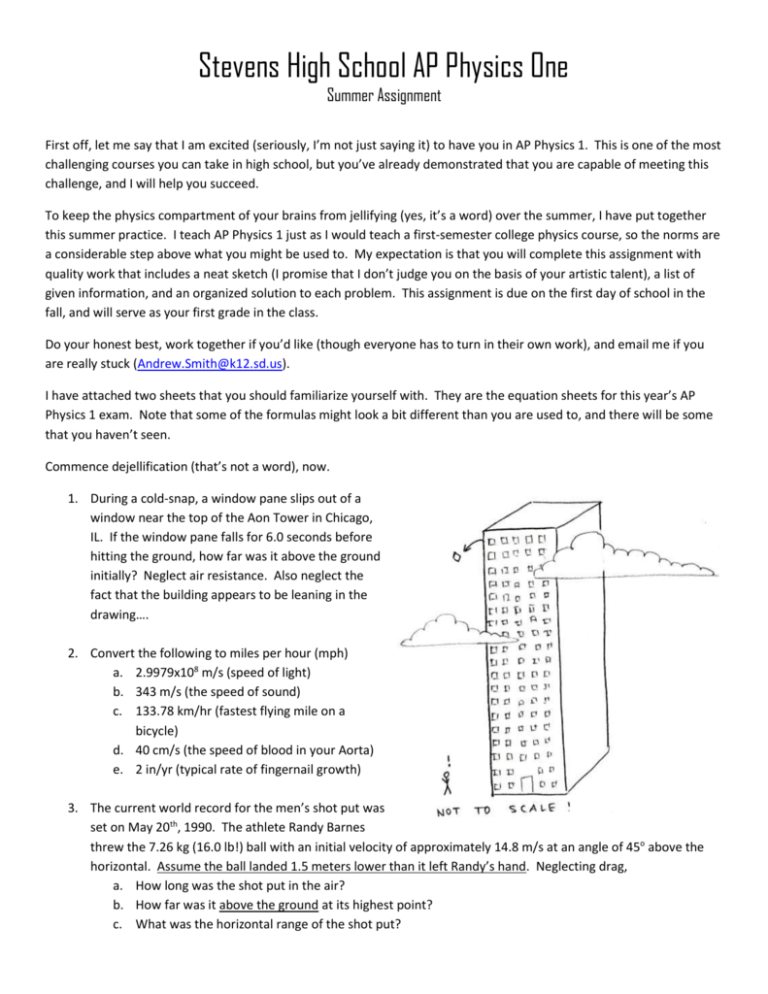
Stevens High School AP Physics One Summer Assignment First off, let me say that I am excited (seriously, I’m not just saying it) to have you in AP Physics 1. This is one of the most challenging courses you can take in high school, but you’ve already demonstrated that you are capable of meeting this challenge, and I will help you succeed. To keep the physics compartment of your brains from jellifying (yes, it’s a word) over the summer, I have put together this summer practice. I teach AP Physics 1 just as I would teach a first-semester college physics course, so the norms are a considerable step above what you might be used to. My expectation is that you will complete this assignment with quality work that includes a neat sketch (I promise that I don’t judge you on the basis of your artistic talent), a list of given information, and an organized solution to each problem. This assignment is due on the first day of school in the fall, and will serve as your first grade in the class. Do your honest best, work together if you’d like (though everyone has to turn in their own work), and email me if you are really stuck (Andrew.Smith@k12.sd.us). I have attached two sheets that you should familiarize yourself with. They are the equation sheets for this year’s AP Physics 1 exam. Note that some of the formulas might look a bit different than you are used to, and there will be some that you haven’t seen. Commence dejellification (that’s not a word), now. 1. During a cold-snap, a window pane slips out of a window near the top of the Aon Tower in Chicago, IL. If the window pane falls for 6.0 seconds before hitting the ground, how far was it above the ground initially? Neglect air resistance. Also neglect the fact that the building appears to be leaning in the drawing…. 2. Convert the following to miles per hour (mph) a. 2.9979x108 m/s (speed of light) b. 343 m/s (the speed of sound) c. 133.78 km/hr (fastest flying mile on a bicycle) d. 40 cm/s (the speed of blood in your Aorta) e. 2 in/yr (typical rate of fingernail growth) 3. The current world record for the men’s shot put was set on May 20th, 1990. The athlete Randy Barnes threw the 7.26 kg (16.0 lb!) ball with an initial velocity of approximately 14.8 m/s at an angle of 45o above the horizontal. Assume the ball landed 1.5 meters lower than it left Randy’s hand. Neglecting drag, a. How long was the shot put in the air? b. How far was it above the ground at its highest point? c. What was the horizontal range of the shot put? 4. A 50.0 N sled is drug by a kid up a 5.0 m long hill at constant velocity. If the hill is inclined at an angle of 37o from the horizontal, and the coefficient of friction between the sled and the hill is 0.25, what force must the child exert to pull the sled if they pull parallel to the hill? 5. An Olympic diver has a mass of 70.0 kg. The diver steps off a 10 m platform (assume no initial vertical velocity), then strikes the water. Once they hit the water, it takes only 0.45 seconds for the diver to come to a stop. a. How long was she in the air? b. How fast was she going the moment they hit the water? c. What is the average upward force exerted by the water needed to stop her? 6. Kepler-186f is the first validated Earth-size planet orbiting another star in the “Habitable Zone.” This is the region of space around a star within which we would expect to find liquid water. It has a mass of about 7x1024 kg and orbits a star with a mass of roughly 1.0x1030 kg. If it orbits the star at a distance of 0.80 AU (1 Astronomical Unit (AU) = 1.5x1011 m), a. What is the force of the gravitational attraction between the two objects? b. How fast is the planet moving in its orbit? Assume the orbit is circular. 7. Randy Johnson hurls a 98 mph fastball toward home plate. At exactly the wrong moment, a 0.35 kg sparrow flies into the path of the ball moving at 20 m/s perpendicular to the ball’s path, and an explosion of feathers ensues. (This really happened - https://www.youtube.com/watch?v=qwpRHrAh3pk). It looks pretty rough, but honestly, that’s a pretty good way to go if you’re a bird. It’s like taking a walk and getting hit by a meteorite. In any case, if the ball has a mass of 0.145 kg, and the bird and ball stick together during the impact, what is the velocity of the bird/ball immediately after the impact? 8. A parachutist of mass 60.0 kg jumps out of an airplane at a height of 1000 m. The parachute deploys and he lands on the ground with a downward speed of 5.0 m/s. How much energy was lost to drag/friction during the sky dive? 9. The following force vectors act on an object: 1) A 50.0 N force pulling at an angle of 45o north of east, 2) A 25.0 N force pulling at an angle of 30.0o south of east, 3) A 65.0 N force pulling due south, and 4) A 34.5 N force pulling at an angle of 15.0o west of south. Calculate the resultant net force (magnitude and direction). 10. A 0.20 kg mass is oscillating on a spring on a horizontal frictionless surface. When it is at a displacement of 2.6 cm from equilibrium, it possesses a kinetic energy of 1.4 J and a potential energy (due to the spring) of 2.2 J. What is the maximum speed that the mass can have while oscillating? 11. A helicopter is travelling at 40.0 m/s at an altitude of 100 m over a stretch of level ground when a bolt is shaken loose and starts to fall. What will be the velocity of the bolt when it hits the ground? 12. A chime (a hollow tube open on both ends) has a fundamental resonant frequency of 440 Hz when struck in air (assume the speed of sound is 343 m/s). a. How long is the chime? b. What would be the fundamental frequency if the chime was struck underwater where the speed of sound is 1520 m/s? c. Draw the fundamental waveform, and the next two higher harmonics. 13. Four resistors, a 15, 12, 20, and a 6 are placed in series with a 10.0 V battery. What is the total current in the circuit? What is the power dissipated by each resistor? 14. Now, for some active pursuits! a. Go outside (on at least three consecutive summer nights) and observe the star Algol. This should help: http://www.starrynighteducation.com/skychart/. It should automatically enter your latitude and longitude. If not, look it up for Rapid City or wherever you are solving this summer assignment. Algol is in the constellation Perseus. Note how it’s brightness changes. Now realize that this is due to the fact that it is actually two stars orbiting each other….VERY RAPIDLY. b. While you’re at it, go hiking at night, and notice how much warmer you feel if you stand under a tree on a clear night than you do when you stand directly under the sky. Why? c. August 14, 2015. There will be no moon, and the Perseid Meteor Shower will be at its peak tonight. It should be awesome! Observe it. If you’re lucky, you’ll get to see a ‘fireball’ when a meteor violently breaks up with as much energy as a small nuclear weapon. I’ve only seen one in my life. d. Go to a lake (not necessarily at night), swim out so that the water is about 10 feet deep (this presumes you can swim, do not attempt if you cannot swim – or learn to swim, then try), and dive down to the bottom. Notice how much colder the water is just beneath the surface and think about why. e. Take out an old-fashioned compass during a thunderstorm (or watch a video of this phenomenon if you are compass-deprived). Observe and explain the effects. f. While watching this thunderstorm, explain why weather around here almost always seems to come in from the west. g. Ride a bike. Why does it get progressively harder to balance the slower you ride?


